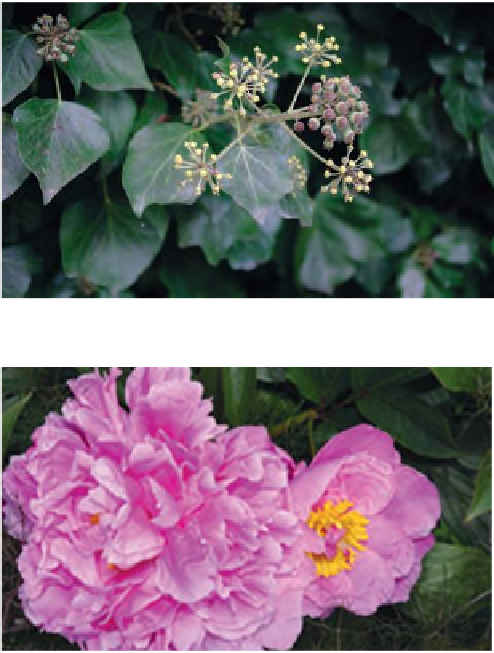Agriculture Reference
In-Depth Information
Whether planting should be native or non-native is
a subject of much debate. Native plants are often
considered the 'best'. This is because they have
evolved alongside the organisms that use them over
a long period of time so support the greatest number
of organisms of which many will be dependent on a
particular plant and adapted to it. For example, the
oak tree is often cited as supporting over 400 species
of invertebrates. However, these will not all be found
on a single tree at any one time. Furthermore, most
invertebrates are not limited to one tree species,
they are generalists rather than specialists. Even
within Britain and Ireland, some species are only
truly native in some localities.
Pinus sylvestris
(Scots
pine), for example, a 'native' tree, is only native to
Scotland, that is, records show it was growing there
at the end of the last Ice Age. In Southern England
it has been planted. Similarly, there is evidence that
Acer platanoides
(sycamore) may have been native in
northwest England originally, but elsewhere it is an
introduced species and is frequently removed. Even
native trees such as
Quercus robur
(oak) may have
been planted from European sources sometime in
the past, so would be genetically different from local
ones. In effect, any tree is useful whether native or
not and numerous naturalized and exotic plants such
as lavender, buddleja, borage,
Sedum
spectabile
,
Cotoneaster
and
Echium
are known to be excellent for
wildlife.
In some situations, plants are selected that are local to
the site - in this case their
provenance
(see p. 128) is
important because it keeps the genetic strains in the
locality pure, and this may be necessary. However,
most organisms are probably not selective about the
plants they use and it is what they can provide that
counts rather than what they are. The RHS 'Plants for
Bugs Study' is investigating whether the geographical
origin of plants makes a difference to the abundance
and diversity of garden invertebrates. Three beds
have been planted to imitate a garden border each
containing plants from a different geographical zone.
In total more than 34,000 insects have been recorded
in the first two years of the four-year study,which
included 13 species of butterfly, 7 bumblebee species,
more than 211 ground-dwelling beetle species and 27
species of spider.
Lists of plants suitable for attracting wildlife to the
garden are easily obtainable, often they focus on
butterflies and bees but it should be remembered that
plants and planting should encourage all wildlife in
order to provide the greatest variety of organisms to
provide a food source for higher trophic levels in the
food chain (see Figure 3.23).
Figure 3.21
A mature ivy with fl owers and fruits
Figure 3.22
Single (right) and double (left) fl owered
forms in a paeony. Note the stamens present in the
single form
(see petalody p. 102), and so they may be sterile
and lacking pollen and nectar (Figure 3.22). Grasses,
bamboos and ferns are poor food sources for
invertebrates, although they do provide good cover.
Native
plants are those which were present
at the end of the last Ice Age when mainland
Britain and Ireland separated from the rest of
Europe. An example is
Quercus robur
(oak).
Naturalized
plants are those that have been
introduced by humans and have spread and
now reproduce in the wild. An example is
Buddleja davidii
.
Exotic
plants have been introduced by
humans recently and are dependent on human
management. An example is
Lavandula
spp
(lavender).
Cultivated
plants do not exist in the wild
anywhere (e.g. plant cultivars such as
Narcissus
'Tete-a-Tete').





